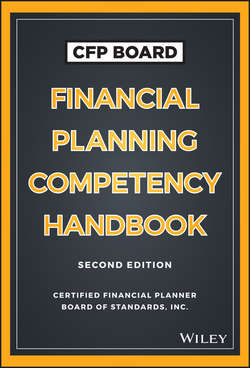Читать книгу CFP Board Financial Planning Competency Handbook - Board CFP - Страница 5
На сайте Литреса книга снята с продажи.
About the Book
ОглавлениеCFP Board is pleased to develop this important work that outlines the knowledge, actions, and contexts associated with financial planning. This book represents the advancement in the profession by practitioners, educators, and researchers in moving toward a universal body of knowledge for the discipline as a whole. This publication is not meant to replace any existing textbook or provide any specific examination preparation, but rather to further the theoretical knowledge base of our growing discipline.
This book serves the entire financial planning profession, including students, faculty, researchers, and practitioners in financial planning and related professions. The book was designed to treat theory and practice not as binary functions, but as one entity, where content was defined but also applied, both within the learning environment and in practice. Part One outlines the 78 topics required to meet the CFP Board Education requirement. Each topic is defined specifically with regard to financial planning and presented in the form of student-centered Learning Objectives. These objectives indicate what the student should be able to do relative to a given concept. The In Class section illustrates ways to facilitate higher-order cognitive thinking relative to each topic in both the traditional classroom as well as the online learning environment. Professional Practice Capabilities outline what practitioners should be able to do relative to three distinct career stages. Vignettes in each chapter, In Practice, illustrate how each particular concept is applied and/or exists in practice. Part Two outlines the domains that are part of the CFP Board Examination requirement. This section defines each of the domains and presents the associated Techniques for completing the domains as well as how they occur In Practice. There are questions specific to each of the chapters in Part One that assess the reader’s content knowledge relative to each of the topic areas. Students can benefit from these questions to test their understanding of these vital areas, as well as CFP® professionals who can also choose to obtain the full 28 credit hours by taking and passing the test. Visit www.wiley.com/go/wileycfpboard2e for more details.
Part Two is devoted to the financial planning process, illustrating the rationale, techniques, and contexts where the process takes place. In this edition, a case, The Jameson Family, runs through each stage of the financial planning process, outlining how each step affects the context as well as how the context can impact each step.
Finally, Part Three focuses on the interdisciplinary nature of financial planning, focusing on both the theory and practical implications of related disciplines such as behavioral finance, marriage and family therapy, psychology, communication, and others. The purpose of Part Three is to bring new theory into this discipline for faculty and researchers while driving implications related to this theory directly to practitioners.
It is important to note that this book is designed to have universal applicability for the profession of personal financial planning. However, certification and practice requirements vary depending upon location of residence. The reader is encouraged to visit www.CFP.net for information about requirements for certification within the United States and www.fpsb.org for information about requirements outside of the United States.
